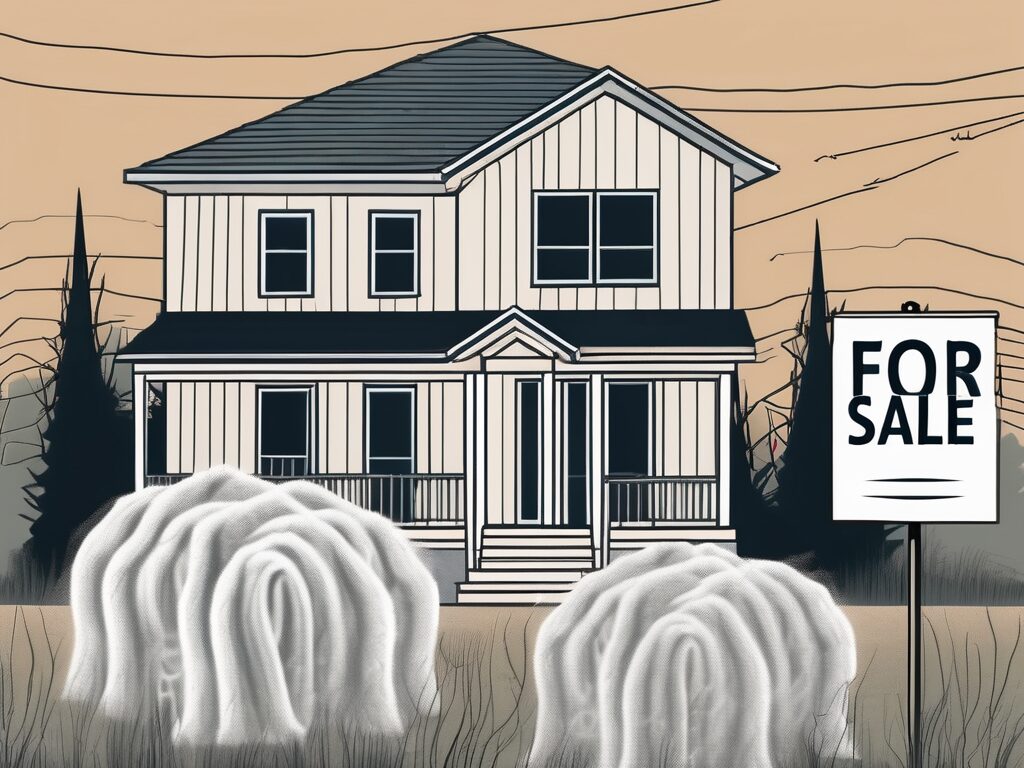
Agent A-Team or Solo Superhero? Finding the Right Real Estate Partner for Your Selling Journey in Wildwood Florida
When it comes to selling your home in Wildwood, Florida,…
January 29, 2024
When it comes to selling your house, there are many factors that need to be considered. One of the most important aspects is ensuring that you disclose any known hazards or issues with the property. This includes the presence of asbestos, which can have serious health implications if not properly addressed. Understanding the dangers of asbestos and how to deal with it is crucial for both the seller and potential buyers. In this article, we will explore the importance of disclosing asbestos when selling your house and provide you with the information you need to navigate this process successfully.
Asbestos, a naturally occurring mineral, has a long and complex history that dates back centuries. Its unique properties, including durability and fire resistance, made it a popular choice for various construction materials. From the 1930s to the 1990s, asbestos found its way into countless homes, serving as insulation, roofing materials, floor tiles, and even textured paints.
During this time, the true dangers of asbestos were not fully understood. Its use was widespread, and its presence in homes went largely unnoticed. However, as scientific research progressed, it became evident that exposure to asbestos could have severe health consequences.
Today, we know that asbestos exposure can lead to serious health conditions, including lung cancer, mesothelioma, and asbestosis. These diseases can develop after long periods of latency, often spanning several decades. As a result, early detection and prevention are crucial in minimizing the risks associated with asbestos exposure.
When asbestos-containing materials deteriorate or become damaged, microscopic fibers are released into the air. These fibers can then be inhaled or ingested, posing significant health risks. The long-term consequences of asbestos exposure can be devastating, making it essential to take proactive measures to minimize exposure.
While certain occupations, such as construction, manufacturing, shipbuilding, and mining, carry a higher risk of asbestos exposure, it is important to note that the danger extends beyond the workplace. Homeowners and their families can also be at risk if their houses contain asbestos-containing materials.
Given the potential health hazards associated with asbestos, it is crucial to be aware of its presence and take appropriate actions. Regular inspections, proper maintenance, and, if necessary, professional removal of asbestos-containing materials can significantly reduce the risk of exposure.
Moreover, it is essential for individuals who work in high-risk industries to undergo regular medical check-ups and screenings to detect any potential asbestos-related diseases at an early stage. Early detection can greatly improve treatment outcomes and increase the chances of successful management of these conditions.
Asbestos, once hailed as a miracle material, has now become a significant concern in the field of public health. Understanding its origins, uses, and associated risks is vital in ensuring the safety and well-being of individuals and communities.
Asbestos, a naturally occurring mineral fiber, was commonly used in construction materials until the late 1980s due to its heat resistance and durability. However, it is now known to pose serious health risks, including lung cancer and mesothelioma, when its fibers are inhaled. Therefore, before selling your house, it is crucial to identify any areas where asbestos may be present to ensure the safety of potential buyers.
Asbestos can be found in various areas of your home. Here are some common places to check:
If your house was built before the 1990s and you suspect the presence of asbestos, it is advisable to consult with a professional asbestos inspector. They have the expertise to identify potential asbestos-containing materials and can collect samples for testing at a certified laboratory. Testing is essential to determine if asbestos is present and to what extent.
If you are considering conducting a DIY asbestos test, it is important to take the necessary precautions to protect yourself and others in the house. Here are some safety guidelines to follow:
Remember, a DIY test can help you identify potential asbestos-containing materials, but it cannot guarantee the absence of asbestos. Professional testing is always recommended for accurate results. When it comes to asbestos, it is better to be safe than sorry.
When dealing with asbestos, repair is often the preferred option if the material is in good condition and unlikely to be disturbed. Professional contractors experienced in asbestos remediation can encapsulate or enclose the asbestos-containing materials to prevent fiber release. This approach can be cost-effective and help reduce the health risks associated with asbestos.
Encapsulation involves applying a specially formulated sealant over the asbestos-containing material. This sealant creates a protective barrier that prevents the release of asbestos fibers. It is a commonly used method for repairing asbestos-containing materials such as pipe insulation, floor tiles, and roofing materials.
On the other hand, enclosure involves constructing airtight barriers around the asbestos-containing materials. This method is often used for larger structures or areas where encapsulation may not be feasible. Enclosure can be done using materials like drywall, plywood, or metal sheets, effectively isolating the asbestos and minimizing the risk of fiber release.
It is important to note that DIY repairs are strongly discouraged, as improper handling or incomplete removal can lead to further fiber release and increased health hazards. Professional contractors have the necessary training, equipment, and knowledge to safely perform asbestos repairs, ensuring the protection of both the occupants and the environment.
In some cases, removal of asbestos may be necessary, particularly if the material is damaged, deteriorating, or poses a significant risk. When it comes to asbestos removal, hiring professionals is highly recommended. They have the expertise and equipment necessary to safely remove and dispose of asbestos-containing materials. Additionally, professional removal ensures compliance with local regulations and minimizes the risk of fiber release during the process.
Professional asbestos removal involves a comprehensive process that includes thorough site assessment, proper containment, and specialized removal techniques. The contractors will establish containment barriers using plastic sheeting and negative air pressure systems to prevent the spread of asbestos fibers. They will also wear personal protective equipment (PPE) to minimize their exposure to asbestos.
Once the asbestos-containing materials are safely removed, they are carefully sealed and placed in designated containers for proper disposal. Professional contractors are well-versed in the legal requirements and disposal protocols for asbestos waste, ensuring that it is handled and disposed of in accordance with local regulations.
Attempting to remove asbestos on your own is not only dangerous but may also lead to legal implications if not done in accordance with local guidelines. The health risks and potential litigation should not be taken lightly, making professional removal the safest and most responsible choice.
In some situations, leaving asbestos-containing materials undisturbed may be an option. This approach may be suitable if the materials are in good condition, not easily accessible, and not likely to be damaged during routine activities. However, it is essential to assess the long-term risks and evaluate future renovation or construction plans that may disturb the materials.
While leaving asbestos undisturbed may seem like a simpler solution, it is imperative to disclose its presence to potential buyers. This allows them to make informed decisions and take appropriate measures to manage the risk associated with asbestos. It is also important to regularly monitor the condition of the asbestos-containing materials to ensure they remain intact and do not pose a threat.
Furthermore, it is crucial to understand that even undisturbed asbestos-containing materials can deteriorate over time due to factors such as aging, moisture, or physical stress. Regular inspections by professionals can help identify any signs of deterioration and determine the appropriate course of action.
Ultimately, the decision to leave asbestos undisturbed should be based on a thorough assessment of the risks, consultation with experts, and compliance with local regulations. It is always better to err on the side of caution when it comes to asbestos, as the health hazards associated with exposure can be severe and long-lasting.
When selling a house with asbestos, it is essential to navigate the legal obligations and considerations to protect yourself and potential buyers. Here are some key aspects to keep in mind:
Research local laws and regulations regarding asbestos disclosure:
Before selling a house with asbestos, it is crucial to familiarize yourself with the specific laws and regulations in your local area regarding asbestos disclosure. Different jurisdictions may have varying requirements, and it is essential to understand and comply with these regulations to avoid any legal complications.
Disclose the presence of asbestos in writing to potential buyers:
Transparency is key when selling a house with asbestos. It is your responsibility to inform potential buyers about the presence of asbestos in the property. This disclosure should be made in writing, clearly stating the existence of asbestos and its location within the house. Providing this information upfront allows buyers to make informed decisions and take necessary precautions.
Provide documentation of any asbestos testing, repairs, or removal that has been carried out:
If you have conducted any asbestos testing, repairs, or removal in the past, it is important to provide documentation to potential buyers. This documentation serves as evidence that you have taken appropriate measures to address the asbestos issue. It can also help reassure buyers that the property has been properly managed and that any potential risks have been mitigated.
Consult with a real estate attorney to ensure compliance with relevant laws:
Given the complexities surrounding asbestos regulations, it is advisable to seek legal advice from a real estate attorney. They can guide you through the legal requirements and help ensure that you are in compliance with all relevant laws. An attorney can also assist in drafting appropriate disclosure documents and provide guidance on any additional steps you may need to take.
Consider obtaining professional advice and inspections before listing your house:
Prior to listing your house for sale, it may be beneficial to seek professional advice and inspections from asbestos experts. These professionals can assess the condition of the asbestos-containing materials, provide recommendations for managing or removing the asbestos safely, and give you a better understanding of the potential impact on the property’s value. Taking these proactive steps can help you make informed decisions and address any asbestos-related concerns before potential buyers become involved.
By fulfilling your legal obligations and being transparent about the asbestos issue, you can build trust with potential buyers and avoid potential legal disputes in the future. Selling a house with asbestos requires careful attention to detail and compliance with relevant laws, but with the right approach, you can navigate the process successfully.
When it comes to selling a house with asbestos, there are important considerations that go beyond legal obligations and ethical responsibilities. Understanding the dangers of asbestos exposure and taking proactive steps to manage it is crucial for the well-being of both the seller and potential buyers.
Identifying asbestos is the first step in this process. Asbestos was commonly used in building materials until the late 1970s, so older homes are more likely to contain it. However, it’s not always easy to spot asbestos with the naked eye. Professional asbestos testing can accurately determine its presence in various areas of the house, such as insulation, floor tiles, and pipe insulation.
Once asbestos has been identified, choosing the appropriate course of action is essential. Depending on the condition and location of the asbestos-containing materials, options may include encapsulation, enclosure, or removal. Encapsulation involves sealing the asbestos to prevent fibers from being released into the air. Enclosure, on the other hand, involves covering the asbestos with a protective barrier. In some cases, complete removal of the asbestos may be necessary.
Ensuring compliance with local regulations is another vital aspect of managing asbestos when selling a house. Different jurisdictions have specific rules and requirements regarding asbestos disclosure and handling. It’s important to familiarize yourself with these regulations and ensure that all necessary permits and documentation are obtained. Failure to comply with local laws can result in legal consequences and potential harm to the health and safety of others.
Education plays a significant role in navigating the complexities of asbestos disclosure. By educating yourself about the potential health risks associated with asbestos exposure, you can make informed decisions and prioritize safety. There are numerous resources available, such as government websites, environmental agencies, and professional asbestos abatement organizations, that provide valuable information on asbestos management and safety practices.
Seeking professional guidance is also crucial when dealing with asbestos. Asbestos removal and management require specialized knowledge and expertise. Hiring a licensed asbestos abatement contractor can ensure that the process is handled safely and effectively. These professionals have the necessary training, equipment, and experience to properly handle asbestos-containing materials and minimize the risk of exposure.
In conclusion, selling a house with asbestos involves more than just legal and ethical obligations. It requires a comprehensive understanding of the dangers associated with asbestos exposure and the ability to make informed decisions. By identifying asbestos, choosing the appropriate course of action, ensuring compliance with local regulations, educating yourself, and seeking professional guidance, you can prioritize safety and protect the well-being of both yourself and potential buyers.

If you want the Richr team to help you save thousands on your home just book a call.
 Book a call
Book a call